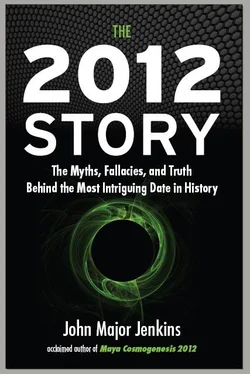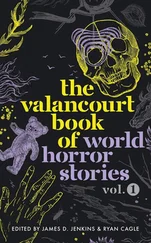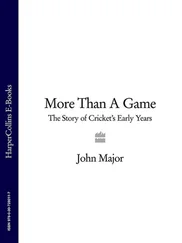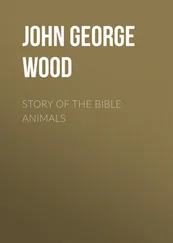At San Bartolo, Izapa, and Calakmul archaeologists have found murals, sculptures, and carvings depicting very early scenes from The Popol Vuh that are more than 2,100 years old—right around the time that Long Count dates began to be carved on monuments. Why did the ancient people of Mesoamerica create the Long Count? Who were they, where was it done, and when? These are important questions to explore if we really want to understand the 2012 story.
When my investigation of the Maya calendars began some twenty-five years ago, there was no context in academia for studying 2012, and the scant references in the literature were completely unconcerned with trying to reconstruct the original intentions of the Maya. (Waters’s book Mexico Mystique is the exception, which I’ll discuss in Chapter 3.) In an effort to pierce the many layers of disinformation that accrete around the 2012 topic, we should consider these four guiding questions to be paramount to understanding 2012, indispensable if we care at all about the authentic perspective on the meaning of the cycle-ending date in 2012: What is the Long Count calendar, how does it work, where was it developed, and when?
It’s a bizarre fact that the vast majority of current commentaries on 2012 (including popular books, academic appraisal, and mass media documentaries) do not concern themselves with these questions. It’s as if approaching 2012 through the tradition that created it is anathema, is irrelevant, is a distraction from the juicier hype that is supposedly “what the public wants to hear.” Why this incredible disregard for the most obvious, and clearest, approach to 2012? The best I can surmise is that 2012 has gained the status of an icon, a cultural symbol, to be used and often abused for purposes that have nothing to do with its origins and the intentions of its creators.
It’s important to hold up a mirror to what is happening in the 2012 discussion, which I’ve observed gaining steam for two decades, and identify this one overarching circumstance. Doing so will help us understand why the 2012 discussion is such a mess and difficult for newcomers to navigate. And yes, gaining a good working knowledge of the Maya calendar system takes some commitment and study. But by sweeping the Maya source of the 2012 topic under the carpet, the way has been cleared for a smorgasbord of underinformed writers and market-driven hypesters to pillage 2012 on their way through to the next trendy topic. The solution? Well, it’s simple: Ask the four questions and go right to the heart of the 2012 calendar. We’ll undertake this first, and later we’ll look at the wider implications of the 2012 cultural meme (a meme is an idea complex that takes on great meaning and spreads).
Approaching the thing in itself, it must be said, is not necessarily easy. Not as easy as spinning out clever designer interpretations, recycled doomsday prophecies, or relabeled ascension techniques. What is really at stake, and what will be meaningful after 2012, is the accurate recovery of a lost paradigm, a forgotten cosmology. The problem is that the answers to the four questions are, on one level, not that clear cut. The precise “when and where” of the origins of the Long Count are not laid out in some hieroglyphic text. On the other hand, investigators of 2012 (“2012ologists,” as I’ve called them) should be willing to work harder than that. After we’ve made some informed deductions about the Long Count’s purpose and origins, we will be able to identify some very clear answers.
Several reconstructions of the origin point of the Long Count have been offered by scholars. Despite the complex relationships between the Long Count, the 260-day tzolkin (pronounced zol-KEEN), and the 365-day haab, scholars have attempted to track the calendars backward to when all the various cycles met at a seasonal quarter, such as the summer solstice. With this methodology, Munro Edmonson proposed that the Long Count was inaugurated on the June solstice of 355 BC, when all the cycles came together. 4Other scholars suggested other dates, and it’s hard to really know for sure which criteria defined the procedure for the ancient calendar makers. There’s no direct evidence.
It’s certain, however, that by 36 BC the Long Count was being carved in stone, because on Stela 2 from Chiapa de Corzo in Mexico we find the date 7.16.3.2.13, corresponding to December 6, 36 BC. Five years later, the famous Stela C from Tres Zapotes was carved with the date 7.16.6.16.18 (corresponding to September 1, 32 BC). On both these monuments, the full Long Count date could be reconstructed. An incomplete Baktun 7 date is recorded on Stela 2 from Tak’alik Ab’aj, meaning it must have been carved before the commencement of Baktun 8 in 41 AD. The Baktun number is clearly 7, but the Katun could be 6, 11, or 16, meaning possibly as old as 236 BC, 137 BC, or 39 BC. If it represents the last possible date in the 16th Katun of the 7th Baktun, it would correspond to July of 19 BC. There’s a fair chance it is the oldest Long Count monument known.
Continuing farther down the Pacific coast from Tak’alik Ab’aj, a well preserved late Cycle 7 monument at El Baúl clearly reads 7.19.15.7.12 (March 2, 37 AD). Stela 5 from Tak’alik Ab’aj contains two Long Count dates; one is clearly 126 AD and the other is either 83 AD or 103 AD. Farther to the north but within the region known as the Isthmus of Tehuantepec, the site of Cerro de las Mesas contains two early Cycle 8 dates. 5La Mojarra Stela 1, inscribed in “the Isthmian script,” contains Long Count dates corresponding to 143 AD and 156 AD. 6Linda Schele was able to date the Hauberg Stela with astronomical references in its inscription to March of 197 AD (Long Count 8.7.17.14.4). 7
However far back the Long Count’s origins may go, something definite happened in the middle of the first century BC—it was carved in stone. As scholar Prudence Rice said, “time became materialized.” 8The willingness to commit the calendar to stone could be considered analogous to images of the Buddha, which only began to appear hundreds of years after he lived. Before that, it was forbidden. However, we can’t even be sure that there wasn’t a previous legacy of uncarved Long Count records written on perishable bark paper. But the material evidence, assessed at face value, suggests an appearance of the tradition in the first century BC.

“Cycle 7” (355 BC to 41 AD). Drawing by Barbara MacLeod
As for where this occurred, the locations of the earliest Long Count dates embrace a rather large region of southern Mexico, stretching through the Isthmus of Tehuantepec south along the Pacific coast (a region called Soconusco) and into the steep coastal piedmont of Guatemala. The southern part of this Isthmian region was home to a pre-Maya culture called by Michael Coe “the Izapan civilization.” 9

The Isthmian region, origin of the Long Count. After Rice (2007)
Vincent Malmström emphasized that Izapa is situated at an important latitude, 15° North. Within the tropics, the sun can pass through the zenith, the exact center of the sky overhead. It does so at high noon on two days every year, but the exact days depend on your latitude. It just so happens that at Izapa, the solar zenith transit dates are May 1 and August 12. These dates divide the year into 105- and 260-day sections. Furthermore, August 12 is within a day of the zero date of the 13-Baktun cycle of the Long Count. Izapa’s latitude thus highlights the 260-day period and the zero date (or “base” date) of the Long Count. For these reasons, Malmström and other scholars believe that Izapa was the origin place of the 260-day tzolkin as well as the Long Count calendar. 10
Читать дальше














